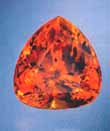Topaz

In antiquity, yellow, brown, and sometimes green gemstones were called "topaz". The name
probably came from the name of an island in the red sea, now Zebirget, but formally
"Topazos".
The colored stones are rarely vivid. The most common is yellow with a
tint of red. The most valuable is pink. Siberian topazes lose some color in the
sunlight. Scratching the rough stones is inadvisable due to cleavage. Care should be taken in
the polishing and setting for the same reason.. They are not resistant to sulfuric acid.
- Color : Colorless, yellow, red-brown, light blue, pinkey, red, pale green
- Color Streak : White
- Moh's hardness : 8
- Specific gravity : 3.53-3.56
- Cleavage : Perfect
- Fracture : Conchoidal, uneven
- Crystal system : Orthorhombic, prisms, with multifaceted ends, often 8-sided in cross section striations along length
- Chemical composition : Al2(SiO4)(F,OH)2 fluor containing aluminum silicate
- Transparency : Transparent
- Refractive index : 1.610-1.638
- Double refraction : +0.008-+0.010
- Dispersion : 0.014
- Pleochroism : Yellow; Definite; Lemon-honey-straw yellow.
Blue; weak: light blue, pink, colorless
Red: definite; dark red, yellow, pink red
- Absorbtion spectrum : Pink 6828
- Flourescence : Pink: Weak; brown
Red: weak; yellow-brown
Yellow: Weak; orange-yellow
